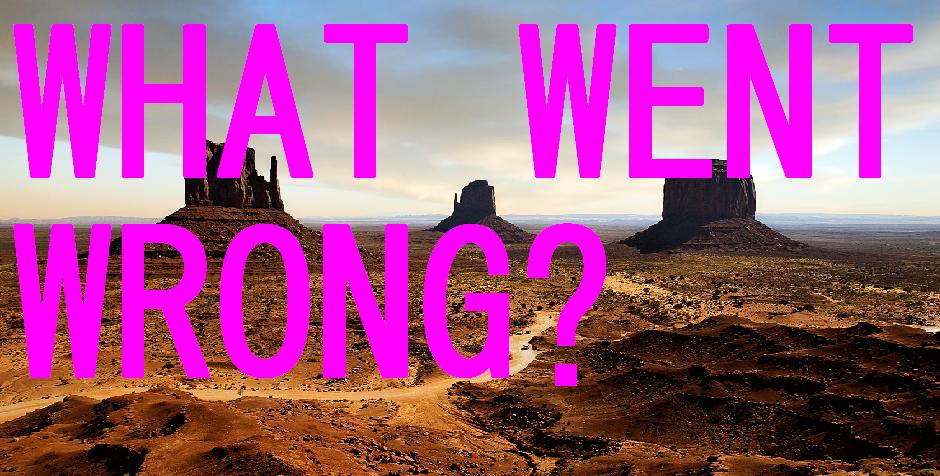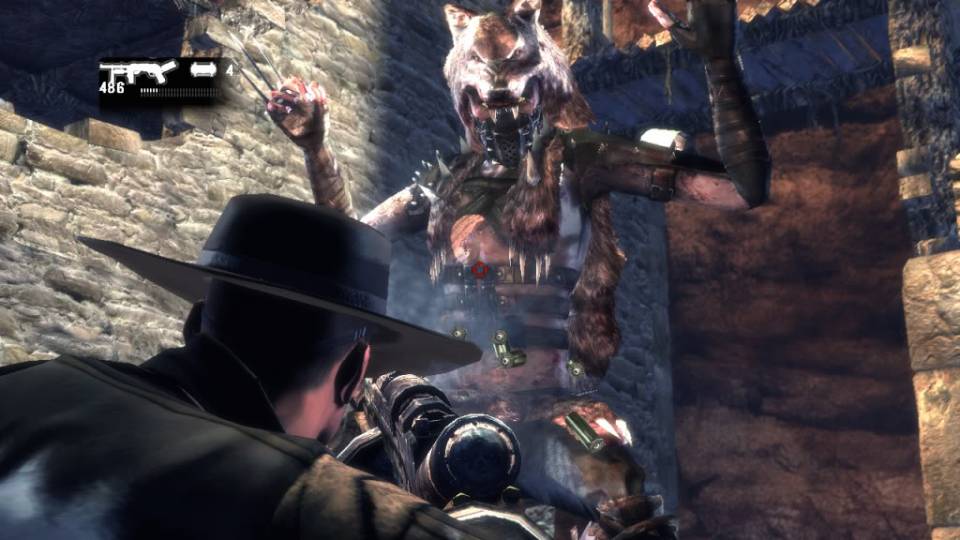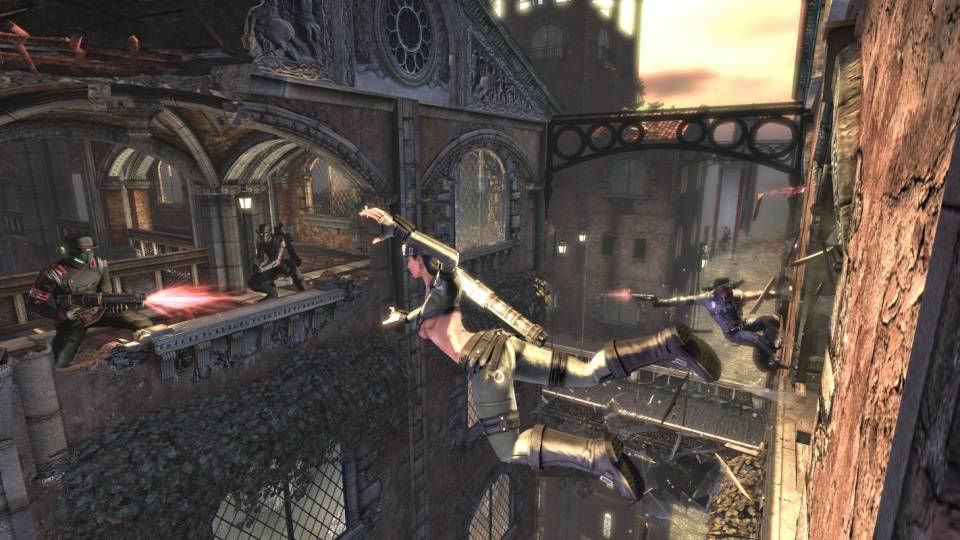The Failure of ‘Damnation’ with Lead Designer Jacob Minkoff
By MMMman 23 Comments

Damnation met with unanimous derision upon its release in 2009 and then disappeared, its only achievement it being one of the worst critically received games for a decade. The product of first time developer Blue Omega, Damnation was to be a revolutionary combination of fast and hard gun-play, vehicular combat and traversal and sprawling, organic level design. Its story would sidestep cliché by reimagining the American civil war as a conflict driven by steam and not gunpowder, where airships, mechs and giant tanks were common sights. History and fantasy would collide in a maelstrom of bullets, acrobatics and heroism resulting in a game quite unlike anything that had come before it. Almost everything the team set out to achieve with Damnation was realised, though often in only the most tenuous of ways. The game was universally criticised for being awkward and stilted, visually bland, incoherent and half-finished. I spoke to Lead Designer Jacob Minkoff in an attempt to discover why Damnation showed so much promise, yet failed to deliver on all but the most basic of levels.
“Games are, I firmly believe, the hardest possible type of media one can work in” Jacob told me on a cold November morning. “There’s a formula to making a good story, and every time you watch a film it plays out the same way – but there is no formula to making ‘fun’.” Indeed, even the most linear of games is a collection of systems that all play important roles, where the failures of one often conspicuously hinder the others. Damnation was not to be a simple linear game though; Jacob’s design documents peg it as the ‘next step in the evolution of the shooter’. Damnation was intended to be something very special.
Damnation germinated from a hybrid first/third person action game entered into the first Make Something Unreal competition in 2004. While it did not win, production was continued with a full retail release as the ultimate goal. Aspirations were high within the team and their plans for the game were suitably lofty. Its ace up the sleeve was to be its gigantic levels. Rather than follow generally accepted design conventions and create locales from smaller, more self-contained segments, the team wanted Damnation’s locations to be huge and open, so the player could clearly see where they had come from and where they were headed. Ambitious claims that the player would be able to see ‘3 hours of game play stretching out before and behind them’ are astounding in their audacity; especially at a time when shooters were still dragging players through courtyards connected by hallways and corridors.
Before and behind didn’t just mean horizontally, either, as many of Damnation’s locations would also open up vertical space to the player. Buildings and terrain were to be more than window dressing; they were important tactical tools that could be utilised by the innovative player to their advantage. A rooftop could provide the perfect vantage point until the player is spotted and the advanced enemy AI begins flanking manoeuvres. Suddenly this advantage becomes nothing more than a place of momentary respite until the player is forced to flee for their lives, leaping through gunfire to an adjacent window, across the fifth floor of a building and then down to the street via a flagpole. Blue Omega was aiming high with Damnation; they wanted to create huge battlefields that player and adversary alike could traverse any way they saw fit. They were seeking to create both organic locations and enemies, throw the player into the mix and watch the emergent game play spiral out of control in the most fantastic of ways. Things did eventually spiral, though no one, especially the player, benefited in the least.

“When we started we just didn’t consider the possibility that we could fail” explained Jacob, rationalising his team’s high expectations. “Please note that I say that with a certain amount of pride. There is no room for self doubt in the creation of any great work.” He does, though, concede that “Damnation was a product of a green team that didn’t really know what they were doing. It was my first professional game development project; the same was true of many members of the core team.” It seems that Blue Omega’s hefty aspirations, some which bordered on the ridiculous at times, were borne out of their inexperience rather than any tested and proven experience. With this in mind, sound bites like ‘hundreds of animation per character’ and ‘the most detailed AI routines yet seen’ cease sounding like possibly attainable goals, and become hyperbolic and fantastical.
The eagerness of the team also led them to overlook the huge challenge set by the new console hardware they were developing for. “We were on the cusp of a new generation and we learned lessons that have since become common knowledge in game development.” In trying to expand upon Damnation so dramatically whilst working with new hardware Blue Omega tried to accomplish too much too soon. “Making a sprawling (theoretically) AAA game on console and PC was simply too much for us to handle”, Jacob told me regretfully. This problem was only exacerbated by the decision to outsource large portions of the game and maintaining an uncommonly small in-house team. The strategy was originally intended to afford this core team the greatest level of flexibility and allow them to adapt throughout development, though as Jacob revealed to me, this simply was not the case in practice. “Outsourcing was a problem, you need the time, experience and budget to turn on a dime – to throw out what you’ve made and try something else quickly, and within constraints. We did not have the resources or knowledge to do that at Blue Omega.”
This ironic inflexibility, borne out of inexperience and outsourcing, led to the game’s woefully protracted development cycle. Few games command four years to make and when they do finally see release this time is usually justified by high levels of polish and production value. This was the opposite case for Damnation. The longer it stayed in development the more out of touch and less impressive it became. Level architecture, AI, textures, animations, movement, physics, audio mixing, sound effects, dialogue, cut scenes, acting, weapons and general common sense all had their merits eroded over the years it took Damnation to gestate. ‘The most detailed AI routines yet seen’ devolved into enemies standing in place until the player came within twenty feet and activated them; considering levels were hundreds of feet long, wide and often high, this left a huge margin for error. Entire enemy encounters could be circumvented with only a sniper rifle and steady aim as foes were picked off one at a time, all elements of challenge, tension or believability falling away to reveal Damnation’s hollow interior. This is not simply me being cruel and using the most egregious errors; every mechanic, design decision and art asset suffers the same terrible, crushing, worst-case-scenario fate, nothing holds up as it should.
While the game showed so much promise and its team so much enthusiasm, its ultimate downfall was to be sealed by entities that care little for either. “In the end, you usually run out of time or money. With Damnation, we ran out of both. One of the primary reasons why you see so much architectural re-use is because it was cheaper to pay for a re-texture than all new geometry. It also took less time to do so, giving us more hope of us meeting our release date.”

I find it terribly sad that Damnation was a failure. The aspirations of the team were noble, and can still be seen peeking through the murk at times. While far from the organic lived-in locations they were intended to be, the levels are still undeniably impressive. Towering cliffs, precarious buildings and death-defying leaps all do exist, they are simply not particularly attractive, inspiring or mechanically fluid enough to be awe inspiring. The AI is rather terrible, though sometimes shows hints of how good the game could have been had the enemies been more intelligent. The aforementioned architecture reuse really hurts what could have been strikingly diverse locations, though the game is still varied enough to be bearable. That is what I find so frustrating with Damnation; it could have been a great game had the team been more experienced, focused and time-efficient. Jacob sees the silver lining; however, “Many games never ship at all because the investment to make the game simply pass console certification would be prohibitive. That it shipped at all is a triumph for Damnation’s team.”
His positivity likely emanates from where Damnation took him next and where he was able to take its fundamental concepts. After the game’s completion Jacob moved to Naughty Dog and designed some of the most memorable sections of the Uncharted sequels. There he was finally able to realise his ambitions for Damnation thanks to an experienced team and appropriate resources. That the similar, yet vastly superior, first Uncharted game was in development at the same time as Damnation, and saw release two years earlier to critical acclaim, is an irony that is not lost on Jacob. Instead of wallowing in the past, however, he is looking toward the future and still building upon his first game’s auspicious past. “Everyone has to learn somewhere. I learned on Damnation.”
